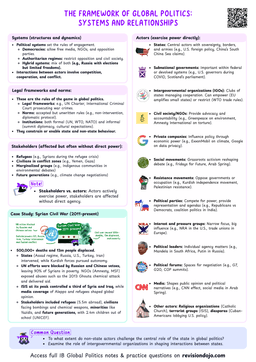Peacebuilding
Peacebuilding
Peacebuilding is about developing positive peace to reduce the chances of future conflict. It includes efforts at all stages, from stopping war to rebuilding society.
Ramsbotham’s Hourglass Model
- Visualises how conflict escalates and de-escalates.
- Top bulb: Conflict escalation → difference → contradiction → polarization → violence → war.
- Neck: Peak of conflict (decision point – escalate or resolve).
- Bottom bulb: De-escalation → ceasefire → agreement → normalization → reconciliation.
- Associated actions:
- Conflict transformation → addressing root causes, changing attitudes.
- Conflict settlement → short-term fixes (e.g., ceasefires).
- Conflict containment → limit violence.

Analogy
- Think of an hourglass as a conflict timeline.
- The sand at the top is tension building up (conflict escalation), the neck is the crisis point (war/peak violence), and the bottom is efforts to clean up the mess and prevent it from happening again (de-escalation and peacebuilding).
Theory of Knowledge
- To what extent does how we frame the stages of conflict influence our understanding of peace and violence?
Core Elements of Peacebuilding
1. De-escalation
- Involves peacemaking, peacekeeping, and DDR (Disarmament, Demobilization, Reintegration).
- Starts once immediate violence stops and supports long-term transformation.
Colombia Peace Deal (2016)
- The Colombian government signed a ceasefire and peace agreement with the FARC guerrilla group after decades of armed conflict.
- Included Disarmament, Demobilization, and Reintegration (DDR) of fighters, monitored by the UN.
- Marked a shift from active violence to structured peace talks and reconciliation.

2. Rebuilding Infrastructure / Reforming Institutions
- Reconstructs physical, social, economic, and political structures.
- Prevents recurrence by tackling root causes (e.g., inequality, injustice, weak institutions).
Rwanda Post-Genocide Reconstruction
- After the 1994 genocide, Rwanda focused on rebuilding schools, hospitals, and roads.
- Major reforms in justice, governance, and education, including the creation of Gacaca courts to address backlog of genocide cases.
- Helped restore state functions and reduce long-term conflict risk

3. Addressing Injustices
- Includes criminal tribunals and truth commissions.
- Goes beyond punishment to healing (e.g., truth-telling, reparations, forgiveness).
South African Truth and Reconciliation Commission (1995–2002)
- Investigated apartheid-era human rights abuses.
- Provided victims a platform to tell their stories; perpetrators could seek amnesty for full disclosure.
- Focused on truth-telling, healing, and national reconciliation over retributive justice.

International Legal Mechanisms
1. International Criminal Tribunals
- Prosecute war crimes and crimes against humanity (e.g., ICTY, ICTR, Sierra Leone).


